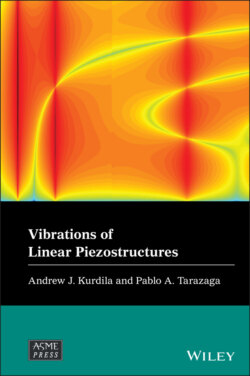Читать книгу Vibrations of Linear Piezostructures - Andrew J. Kurdila - Страница 14
1.1.1 Ferroelectric Piezoelectrics
ОглавлениеPerhaps one of the most important classes of piezoelectric materials that have become popular over the past few decades are the ferroelectric dielectrics. A ferroelectric can have coupling between the mechanical and electrical response that is several times a large as that in natural piezoelectrics. Ferroelectrics include materials such as barium titanate and lead zirconate titanate, and their unit cells are depicted in Figure 1.1. When the centers of positive and negative charge in a unit cell of a crystalline material do not coincide, the material is said to be polar or dielectric. An electric dipole moment is a vector that points from the center of negative charge to the center of positive charge, and its magnitude is equal to where is the magnitude of the charge at the centers and is the separation between the centers. The limiting volumetric density of dipole moments is the polarization vector . Intuitively we think of the polarization vector as measuring the asymmetry of the internal electric field of the piezoelectric crystal lattice. Ferroelectrics exhibit spontaneous electric polarization that can be reversed by the application of an external electric field. In other words, the polarization of the material is evident during a spontaneous process, one that evolves to a state that is thermodynamically more stable. Understanding this process requires a discussion of the micromechanics of a ferroelectric.
Figure 1.1 Barium titanate and lead zirconate titanate. (Left) Barium titanate with cation at the center, anions on the faces, and cations at the corners of the unit cell. (Right) Lead zircanate titanate with or cation at the center, anions on the faces, and cations at the corners of the unit cell.
The micromechanics of ferroelectric dielectrics is subtle and interesting. Above a critical temperature , the Curie temperature, the crystal structure of a ferroelectric is usually symmetric, and a plot of the polarization versus applied electric charge is generally nonlinear and single‐valued as shown in Figure 1.2.
However, with cooling below the Curie temperature , a thermodynamic process drives a structural phase transition so that the final crystalline phase has a lower symmetry. At the lower temperature it can be shown [18] that the lower symmetry crystal phase has at least two energetically equivalent configurations or variants. Furthermore, with the application of an external electric field, it must be the case that it is possible switch among these crystalline variants in a reversible process. The ferroelectric material forms domains that consist of these energetically equivalent crystalline variants. Figure 1.3 depicts schematically the and domains [31] that can appear in single crystal barium titanate [31]. Note in the figure that the polarization vectors are opposite from one domain to the next, and their average polarization over a macroscale can have zero effective polarization. Because of the presence of these domains, below the Curie temperature the polarization versus applied electric field takes the form of a hysteresis loop as shown in Figure 1.4. Initially, the domains cancel their effects over the macroscopic specimen and at . The polarization increases as in Figure 1.2 for a range of electric field . When a critical value , the coercive electric field strength, is reached, the domains abruptly switch so that they are approximately well‐aligned with the external electric field. With all domains having approximately aligned polarization vectors, the polarization again follows a nonlinear single valued curve until saturation is achieved. When the electric field is reversed, and reaches the opposite coercive electric field strength , the domains switch again so their polarization vectors are approximately aligned with the second variant. The result of this cyclic process is that after the transient response there is a nonzero polarization, the spontaneous polarization, for an electric field strength . At a macroscopic scale, then, the effective or average polarization can switch with the application of the external electric field.
Figure 1.2 Polarization versus applied electrical field for ferroelectric above the Curie temperature .
Figure 1.3 and domains in , [31].
Source: Walter J. Merz, Domain Formation and Domain Wall Motion in Ferro‐electric BaTiO3 Single Crystals, em Physical Review, Volume 95, Number 3, August 1, 1954, pp. 690–698.
Figure 1.4 Polarization versus electrical field hysteresis below the Curie temperature .
